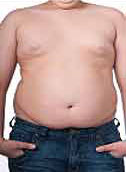- Skip Storing This Everyday Product in the Fridge Door
- Green Tea + B3 Pairing May Boost Brain Health
- Navigating Your Midlife Crisis: Embracing New Possibilities
- City Raccoons Showing Signs of Domestication
- Mapping the Exposome: Science Broadens Focus to Environmental Disease Triggers
- One Week Less on Social Media Linked to Better Mental Health
- Your Brain Changes in Stages as You Age, Study Finds
- Some Suicide Victims Show No Typical Warning Signs, Study Finds
- ByHeart Formula Faces Lawsuits After Babies Sickened With Botulism
- Switch to Vegan Diet Could Cut Your Greenhouse Gas Emissions in Half
Childhood Obesity Brings Host of Health Problems, Researchers Report


Obese children are at increased for liver disease, high blood pressure and heart disease, a new study warns.
Researchers looked at nearly 500 children and teens, aged 2 to 17, with nonalcoholic fatty liver disease (NAFLD), a condition that’s most common among youngsters who are overweight and obese. NAFLD can develop in conjunction with other health problems such as diabetes.
Nearly 36 percent of them had high blood pressure at the start of the study and 21 percent had persistent high blood pressure 48 weeks later. High blood pressure is present in 2 percent to 5 percent of all children and 10 percent of obese children, according to the researchers.
The study showed that children with NAFLD have a significant risk of high blood pressure, which is often undiagnosed.
The study was published Nov. 24 in the journal PLoS One.
“As a result of our study, we recommend that blood pressure evaluation, control and monitoring should be included as an integral component of the clinical management of children with NAFLD, especially because this patient population is at greater risk for heart attacks and strokes,” principal investigator Dr. Jeffrey Schwimmer, from the department of pediatrics at the University of California, San Diego School of Medicine, said in a university news release.
“Hypertension is a main cause of preventable death and disability in the United States in adults, but much of the origin occurs in childhood,” he added.
“Along with being at an increased risk for cardiovascular disease, we found that children with NAFLD who had high blood pressure were significantly more likely to have more fat in their liver than children without high blood pressure. This could lead to a more serious form of liver disease,” Schwimmer said.
He and his colleagues also found that among children and teens with NAFLD, girls were much more likely to have persistent high blood pressure than boys.
While there are no approved treatments for children with NAFLD, there are effective treatments for high blood pressure.
“There are some reasons to believe that blood pressure control could be beneficial for NAFLD. Thus, we may be able to decrease the risk of premature cardiovascular disease in these children, and also help their liver,” Schwimmer said.
“Parents and doctors need to be aware of the health risks of children who have NAFLD. The sooner high blood pressure is identified and treated in this patient population, the healthier they will be as they transition into adulthood,” he concluded.
More information
The American Liver Foundation has more about non-alcoholic fatty liver disease.
Source: HealthDay
Copyright © 2025 HealthDay. All rights reserved.










